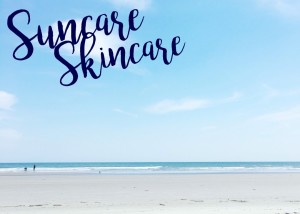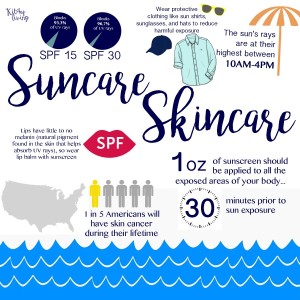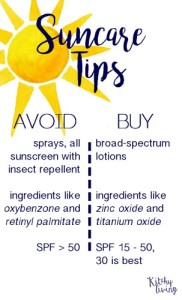Suncare Skincare: Protect Yourself Right This Summer – KitchyLiving.com

Article by Sarah Snyder – KitchyLiving.com
Summer heat is here! Hard to believe it’s only June with the daily highs we’ve been experiencing in Charleston lately. This kind of weather lends itself to more time in the hot sun soaking up that glorious warmth. However, spending more time outdoors means more time for your skin to be exposed to harmful UVA/UVB rays.
Let’s start with the basics…
SPF – AKA “sun protection factor”
In all honesty, SPF is not particularly scientific. It is a determined factor from many test subjects comparing the time in minutes it took them to burn with sunscreen-protected skin vs. unprotected skin. In theory if it takes you 5 minutes to burn without sunscreen, then an SPF of 15 should keep you protected for 75 minutes. Likewise, an SPF of 50 should keep you protected for 250 minutes. SPF 15 blocks approximately 93.3% of harmful rays, while SPF 30 blocks 96.7%. So take into consideration what percent of rays you are willing to let penetrate your skin by choosing an SPF accordingly.
Sunscreen vs. Sunblock
Sunblocks are a physical type of sun protection that block UVB rays with both organic and in-organic ingredients that sit on top of the skin. Sunscreens are a chemical type of sun protection that absorb UVA rays before they reach the deeper dermal layer of tissues. Luckily nowadays most formulas you find at the drug store or beauty counter are broad-specturm meaning they protect against both UVA and UVB rays. But to be sure, look for formulas that boast broad-spectrum treatment on the label.
 Lotion vs. Spray
Lotion vs. Spray
According to the EWG (Environmental Working Group), it’s best to stick with lotion sun protection. Sprays can often be inhaled accidentally which is a hazard if any of the ingredients are harmful. Sprays may be simpler for application on children, but aerosol cans in general are best to avoid if possible.
Ingredients to Avoid
The EWG suggests you steer clear from products containing oxybenzone and retinyl palmitate. Oxybenzone is an endocrine disrupter and when absorbed in the skin can cause an eczema-like response. It’s considered an endocrine disrupter because it changes hormone levels by mimicking, blocking and altering your baseline hormone levels. Retinyl palmitate is essentially an antioxidant, but is used in sunscreen to reduce aging effects. However when retinyl palmitate is exposed to the sun’s UV rays, the retinol compounds begin to break down into harmful free radicals that damage DNA, are toxic to surrounding cells, and may be linked to tumor and skin cancer development.
Honestly, I have a bottle of Hawaiian Tropic in my beach bag right now and it contains two of the more harmful ingredients the EWG warns Americans to avoid. So what now? Well, the EWG curated a fabulous list of sunscreens that they have tested and approved because of their safe ingredients, stability, and UVA protection. Check them out here and see if your current sunscreen made the cut.
Alba Botanica, Aveeno, Badger, Bull Frog, Burt’s Bees, COOLA, Kiss My Face, and Yes To Cucumbers are a few of the companies with approved products that I’ve seen in most drug stores and supermarkets. Save the image below to simply your next sunscreen stock-up!
Next time I’m at the drugstore, I know I’ll be stocking up on chemical-free sunscreen. Proper sun protection is worth the temporary splurge. Your skin will thank you!
More features from KitchyLiving.com


